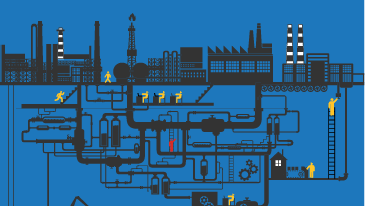Last fall I wrote a blog about how geographical boundaries are blurring in the engineering, procurement and construction (EPC) business. From the growth and expansion of Chinese EPCs to the fabrication of major components in Asia for shipment and installation around the world, I noted that the EPC business is “going global.”
On the heels of AspenTech’s OPTIMIZE 2019 conference in Houston earlier this month, I have some new insights on this globalization trend. In one of the conference sessions that focused on the EPC industry, there were three best-practice case studies on how firms are increasingly relying on professionals located in multiple offices to execute a project.
This may seem obvious to some, but it wasn’t that long ago that projects were primarily done out of one office location. So what’s driving this change? Based on a March 2019 AspenTech survey of EPC executives, 60% of respondents reported opening or closing an office in the past four years, and 58% reported having been part of a merger or acquisition over the same period.
Coupled with the many retirements, reorganizations and the overall hiring gap between 2014 and 2018, it is now almost a given that projects will need support from multiple locations.
When asked why this was becoming the norm, we heard three consistent responses: speed, talent and cost. In fact, anecdotally, some said that while they began this multi-office approach to cut cost, as work has picked back up, it has become more about speed and access to talent.
Speed
Speed is the ability to be more responsive in bidding and executing project work. “Follow the sun” approaches are increasingly common and are enabling engineering firms to work on a project around the clock to meet deadlines and stay on track.
Talent
Accessing talent has become increasingly important. There is now a shortage of experienced engineers in many locations, including the U.S. Gulf Coast.
Being able to tap into talent wherever it is located has become a differentiator for firms with the ability to open and productively operate high-value engineering centers (HVECs) in places like India and the Philippines. In the above-referenced survey, 83% reported having engineering resources in another country.
Cost
While many firms began looking to augment their engineering capabilities to be more competitive on cost, those efforts are now paying off in ways beyond the financial. In fact, rising wages and a growing middle class in places like India and China have eaten into the cost advantage originally envisioned for HVECs.
However, firms are not regretting opening these locations because a cost advantage does remain. And more importantly, they now have access to a larger pool of educated and trained engineers.
Overcoming Challenges to a Globalized Engineering Approach
Roadblocks abound when trying to execute a complex engineering project across locations, time zones and cultures. The top three challenges (based on responses to the survey) are sharing engineering models, consistency in deliverables and dealing with changes.
To deal with these issues, the three presenters at OPTIMIZE offered multiple approaches — from getting the entire team engaged early to implementing standardized work processes and engineering tools. The most important factor was having a central location for the engineering data that serves as a single source of truth for the project data. This was especially important for ensuring things did not fall through the cracks and making sure changes could be completely and consistently incorporated by the entire team, regardless of location.
If you are looking for assistance in these areas, please let me know. AspenTech has pioneered a “data-centric” approach to engineering information that can help with these challenges.
To learn more about leveraging consistent project data across your team to produce better client outcomes, check out our recent executive brief, Performance Engineering: Pushing the Boundaries of What's Possible in the Process Industries.






Leave A Comment